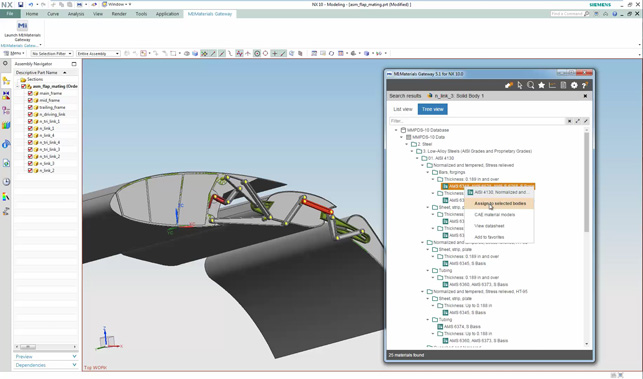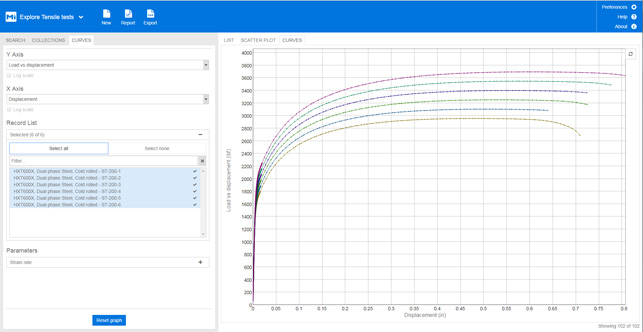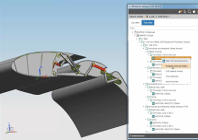
Materials datain Siemens NX10
From creating the most slender, lightweight mobile devices possible, to the use of composites in huge aerospace structures, material-driven product design and engineering is pushing the boundaries of innovation.
Yet, perhaps surprisingly, initiatives to digitalise, manage and apply the information that companies hold about engineering materials (for example, metals, plastics and composites) have lagged behind other areas. Take, for example, the management of product design data: this has evolved into product lifecycle management (PLM). But any CAD user looking for their company’s approved material list and associated property data may have experienced problems.
Why is this? What is changing? And why should you care?
Why have materials lagged behind?
With materials as one of three core variables in the design of every product, along with shape and manufacturing process, it is difficult to understand why materials information management hasn’t been top of every engineering company’s agenda. Several factors have contributed to its being neglected.
For a start, materials information is complex. For any given material, we may have to manage hundreds of properties. Each property may generate many layers of information. It is rich, multi-dimensional and has complicated inter-relationships. Data types required include lists of numerical values; functional, curve, graphical and ‘multi-point’ data; discrete or logical values; relationships; text, documents, notes, and multimedia.
To add to the challenge, this data is dynamic – it is liable to change, for example, when further test data becomes available or when substance regulations are updated.
Finally, a material definition evolves during the transition from conceptual design to manufacture. What starts off being referred to as a ‘strong, stiff plastic’ in the conceptual design phase ends up being described in more specific terms, such as ‘Du Pont Zytel 70G20HSL in Aurora Red’ by the procurement stage, with many stages in between.
The challenges of managing this full ‘materials information lifecycle’ mean that it is often only partially digitalised (if at all), consigning it to unconnected silos.
Not only does this make it difficult to trace and control, it can also lead to costly duplication of tests and simulations.
Critically, this information may be unavailable where and when it’s needed, in order to support analysis, decision making or compliance.
New discipline
So what’s changing? First, expectations and technology around the management of engineering data throughout the product lifecycle have changed enormously in the past decade. Enterprises understand that systematic data management is a ‘must-have’, not just to perform better, but to survive.
As part of this evolution, they are investing in PLM systems and looking for connected areas that have been neglected – and they’re discovering materials.
In parallel, enterprise materials information management has become an established discipline, with supporting tools and a proven track record, driven initially by industries with intensive needs, such as aerospace. Multi-partner projects such as the Material Data Management Consortium (MDMC), which includes Rolls-Royce, Boeing and Honeywell, have defined and implemented best practice.
In response, commercial toolsets like Granta Design’s Granta MI, a system for comprehensive management of materials information, are now available. The wider PLM ecosystem is also thinking harder about materials.
An increasing number of PLM projects include materials information management as a requirement, and PLM vendors are incorporating materials data models and tools. For example, there is Siemen’s Teamcenter IMM module and, with its 3DEXPERIENCE platform, Dassault Systèmes includes a multi-domain materials model, supporting CAD and simulation.

Materials test data using Granta Design’s system for comprehensive management of materials information, Granta MI
How can my company respond?
Every company that uses materials should ask itself: ‘What is my systematic process for managing materials information?’ One of the next questions that flows from this is, ‘Do I need a dedicated system?’
If you use a small number of materials, are interested in a narrow range of properties, have static materials data and don’t need data from external reference sources, then you might tackle the problem with generic tools, such as PLM. If any of these conditions aren’t met, however, it’s likely your organisation could benefit from a system designed for greater depth and breadth of materials data, managing all interrelated data sets (such as engineering property data; descriptions of available grades or processing options; compliance information; rendering and aesthetic properties; and supplier information). In specifying this ‘gold source’ for company materials data, you’ll want to consider issues such as version control, access control and availability of third-party reference data within the system.
A second key question is: ‘How do we get materials data to the people in our company who need it?’ In general, look for an easy-to-use web user interface with the right security and ideally, the ability to plug into company workflows. But this question is quite likely to come down to effective integration with other engineering software. For example, does the system have a means for direct access to materials data needed for simulation from within tools such as Abaqus/CAE, Ansys Workbench or HyperMesh? Or from CAD environments like Creo, NX or Catia?
An interesting trend, as PLM systems improve their handling of materials, is towards synchronisation between PLM and materials information systems. For example, General Motors is using the Granta MI system as its ‘authoring gold source’ for materials information, storing the full complexity of company materials data and its pedigree. The Teamcenter IMM module within its PLM system is used as the ‘consumption gold source’ – the place where design teams find materials data.
‘Catalogues’ of data useful in design and development are defined within the Granta MI database, and these are regularly synchronised with Teamcenter. Crucially, full traceability is maintained so that, at any point, it is possible to find the source of the materials data in PLM and to request further properties.
What’s next?
Materials information management ensures you have confidence in and control over your data, consistency throughout your organisation and can optimise processes and designs. This can help avoid significant risks and costly mistakes, plus users of CAD/CAE can find what they need, when they need it. Ultimately, it makes sense. Why invest in great simulation, CAD and PLM systems and then feed them with inaccurate, incomplete or outdated data? Materials information management is arriving at the digitalisation party. It’s time to check it out.
grantadesign.com

Granta Design on materials information management
Default






